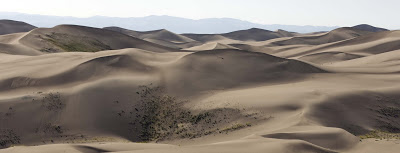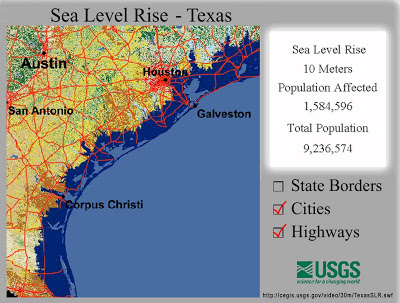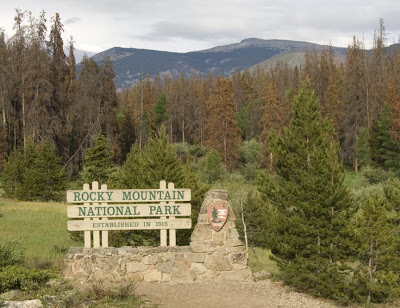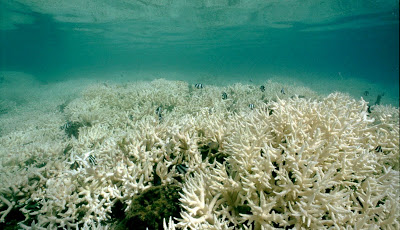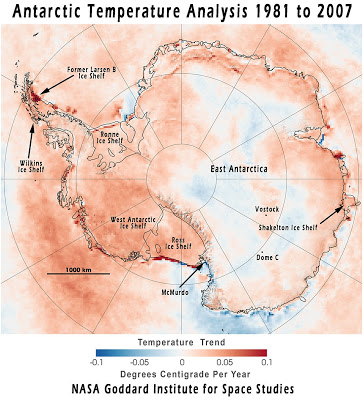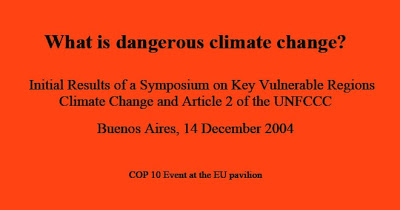Climate Blindness
By Bruce Melton
How do we curb emissions with the way our society has evolved? Really. I mean serious curbing; enough to prevent dangerous climate change?
When considering the answer, dangerous climate change must be clearly defined. So, what exactly is dangerous climate change?
There is a disconnection between climate science and the public’s knowledge of climate change. The knowledge gap is becoming obvious to many, but to the climate scientists it is clear: there is a fundamental blindness in the vast majority of our society as to the meaning of man-caused climate change.
The disconnection itself is not easy to see without expert knowledge. The dendrochronologists have a hard enough time understanding the cryologists (tree ring scientists and ice scientists.)
Even so, the amount of important decision-making class of information being discovered is simply staggering. But the means to deliver this knowledge, to mine it out of the academic jargon and deliver it to the people, is just not there. Once this outreach issue is overcome however, and the disconnection is understood, the blindness becomes obvious.
Researchers at Dalhousie University, Halifax, Nova Scotia, Canada, after evaluating a half million water clarity observations taken from the world’s oceans over the last 100 years, have come to the conclusion that ocean primary productivity has declined 40% since 1950. Primary productivity is that nearly planetary-size mass of life that makes up the algae and plankton in our oceans — it is the bottom of the food chain (1).
As our oceans warm, currents slow, nutrients become scarce and fewer of these creatures inhabit ocean water. These tiny and more often than not microscopic life forms use carbon dioxide to create organic material and tiny plankton shells made out of calcium carbonate, just like clams and oysters.
Once the life form that is using this organic and shell material dies, the remains drift to the ocean floor as what is called marine snow. After hundreds of thousands of years, this material accumulates enough to become limestone.
Primary productivity is responsible for a third to a half of all of the natural carbon dioxide sequestration on Earth, as well as a third to half of the atmospheric oxygen generation on Earth. Many things buffer impacts from the decline of this primary earth system, but tipping points likely exist. Because primary productivity is such a large planetary function, runaway greenhouse gas accumulation in the atmosphere and runaway loss of atmospheric oxygen could be the result.
Such a large change in ocean clarity demonstrated over such a long period as has been found by these Dalhousie researchers is clearly an indicator of great change. These types of earth systems disruptions are happening across the globe with impacts that are changing Earth like it has not changed in tens and even hundreds of millions of years.
From across the globe oceanographers have been grimacing over this year’s coral bleaching event that has likely been worse than during the super El Nino of ’98 — the worst bleaching event ever recorded. Overly warm, or record warm water temperatures are killing coral like mankind has never seen (2).
The Arctic was declared functionally ice-free last summer for the first time in 14 million years in a paper in Geophysical Research Letters, or at the least, the argument was presented by one of the world’s leading Arctic sea ice scientists from the University of Manitoba in Winnipeg, Canada (3, 4).
Ultra high CO2 levels in prehistory were really only a third as high as we thought. Those 3,000 ppm CO2 concentrations back in the Mesozoic hothouse were in actuality only about 1,000 ppm. This means that our 21st century CO2 projection of the worst-case scenario nearing 1,000 ppm is frighteningly close to anything our planet has seen in the last 400 million years.
When we look back in time this far, and realize that modern atmospheric oxygen and carbon dioxide concentrations on Earth were stabilizing during this period after green plants colonized land, the implications of this finding are profound (5). (And yes, unfortunately we are progressing along the IPCC CO2 worst-case scenario (6).)
The dead trees from the pine beetle pandemic in Yellowstone, part of a warming induced bark beetle pandemic in the Rocky Mountains, responsible for 61 million acres of dead and dieing trees, billions of trees, in an area nearly the size of New England and Pennsylvania combined, are visible on Google.
The pandemic is 10 to 20 times larger than anything ever known, is growing rapidly, and scientists fear it will spread across the entire North American continent because its only enemy is extreme cold that has not been seen in more than a decade (7, 8).
October 2010 was the 308th consecutive month with an average temperature above the 20th century average (9).
The evidence in the academic literature is simply overwhelming. But virulent societal tricks have sequestered much of this knowledge. Virtually none escapes the academic literature. The reasons are many and diverse and range from vested interests and religion to the scientists simply not being trained (or willing) to communicate their discoveries to the public in language that can be understood by non-specialists.
This black knowledge hole however, is but a symptom of the disconnection. If just one fundamental definition was understood, the disconnection could simply vanish.
The public’s misunderstanding of the definition of “dangerous climate change” was emphasized to me when I was made aware of a climate survey in the October issue of Scientific American.
Question #8 of the survey, the last question, read: How much would you be willing to pay to forestall the risk of catastrophic climate change? The response was 79.6 percent for “nothing.” (10).
The word catastrophic is often interchanged with dangerous as an outcome to avoid in climate change scenarios and if anything, a catastrophe would be worse than something that is dangerous. Regardless, the terms are often considered to be of similar outcome and will be used interchangeably in the rest of this article.
Anyone following the climate science polls across the country knows that the last decade has seen an actual decline in the public’s knowledge of climate science. In a series of Gallup polls beginning in 1997, the number of poll respondents who think climate scientists are exaggerating increased more than 50 percent (to 48 percent) from 2006. Sixty-seven percent of poll respondents believe that climate change will not pose a serious threat to them in their lifetimes. This is up 16 percent from 2008 (11).
All of this increased disbelief is happening while the science itself continues to grow more and more robust. A study of nearly 1,400 climate scientists agrees that the man-caused tenets of the IPCC are valid. What’s more, of the two to three percent that do not support man-caused climate change science, 80 percent have published fewer than 20 papers, while the IPCC crowd includes only 10 percent that have published fewer than 20 papers (12).
So seeing 79.6 percent of the public say that they would do “nothing” to prevent catastrophic climate change was not, to me, a red flag. It was the key.
If the Scientific American readership could say something like this, surely they just did not understand the definition of dangerous climate change.
Following up, I found that Scientific American had removed the poll from their website. This was curious. I searched more and found an article on the Scientific American site, by the editors of Scientific American, that explained a few things. It seems that the there is one more thing that makes it difficult for the public to understand climate science.
This one more thing unfortunately, is organized deceit. The Watts Up With That website, a prominent climate change denial portal, decided that it would be a good thing to load up the Scientific American poll with opinions from Watts Up With That visitors. Watts Up created a new web page urging its visitors to complete the Scientific American survey.
Their campaign netted 30.5% of the respondents on the survey, likely skewing the results quite significantly. And in an as yet unexplained coincidence, a website called www.smalldeadanimals.com accounted for 16 percent of the survey respondents. A quick visit to this site shows that it too is obviously full of climate change unbelievers.
Another key finding in the Scientific American editors’ investigation was that the number three ranked referring website was a well known climate science site by Joe Romm called Climate Progress. Referrals from this website accounted for only 2.9 percent of the respondents of the SA survey. This information tells us that this poll was definitely ruined by organized deceit emanating from a prominent climate denier website (13).
The underlying concept however, that the public has a significant misunderstanding of the science, as is shown by the Gallup polls (and many others) is still valid. The key to the blindness must be that, if the definition of “dangerous climate change” was understood, even by the climate deniers, the answer that would have been chosen for question #8 would certainly have been something other than “nothing.”
So then, what do the scientists say is the definition of dangerous climate change? The Intergovernmental Panel on Climate Change (IPCC) specifically does not define dangerous climate change. They say that the definition is a value judgment that should be made by policy makers, not the IPCC. They do suggest however that the definition would include threats to our food supply, or the creation of unsustainable economic conditions.
At the European Climate Forum of the United Nations Framework Convention on Climate Change in Buenos Aires in 2004, the topic of dangerous climate change was the main event. They said that dangerous climate change could include circumstances that could lead to global and unprecedented consequences, extinction of “iconic” species, loss of entire ecosystems, loss of human cultures, water resource threats, and substantial increases in mortality.
They say these dangers could include Arctic sea ice retreat, boreal forest fires, increases in frequency of drought, widespread dangers over a large region, most likely related to food security, water resources, infrastructure, or ecosystems (14).
An abrupt sea level jump would be a dangerous climate change. The last time Earth was as close to being as warm as it is today, 121,000 years ago, sea level jumped 10 feet in 100 years for 300 years in a row (about 10 meters total). The jump was likely because of collapse of the West Antarctic Ice Sheet (WAI), and it has been shown that the WAI is destabilizing now. (15, 16)
A sea level rise of just one foot per decade (30 mm), just an inch and three sixteenths per year, would wreak utter havoc across the planet after just a couple of years. To start with, the United States Geological Survey, Environmental Protection Agency, National Oceanic and Atmospheric Administration, and Department of Transportation say, in a mega report from 2009, that the threshold for regeneration of coastal barrier islands and coastal wetlands is just a quarter of an inch (seven millimeters) per year of sea level rise.
This means that sea level rise of greater than a quarter of an inch per year would either cause the disintegration of our coastal barrier islands and wetlands, or keep them from naturally regenerating after they are gone.
There are 405 barrier islands on the Atlantic and Gulf Coasts of the U.S. totaling over 3,000 miles in length and there are 5.3 million acres of coastal wetlands. All would be destroyed.
This documented rate of sea level rise of an inch and three sixteenths per year is more than four times greater than the barrier island and wetland disintegration threshold. Our coastal defenses against storms would completely disappear, taking their trillions of dollars of weather defenses with them, not to mention the loss of one of the most productive eco regions on the planet (17).
When the beaches go, the refugees begin to flow, millions per year. Then the world’s coastal infrastructure begins to submerge. Nearly half of Earth’s industrial capacity is close to sea level.
Over the last 100 years, sea level has risen only five or six inches. Across the globe 233 million people would be displaced by 10 feet of sea level rise. This is 2.3 million climate refugees per year. The United States Geologic Survey says that a 10-meter sea level rise, something like what happened 121,000 years ago, would flood a quarter of the United States population (about 78 million Americans), and nearly 1 billion people worldwide (870 million) (18, 19, 20).
And what of the 2007 IPCC projection of about a foot of sea level rise this century? They do not take into consideration, and the IPCC scientists persistently and frequently caveat their report in the text and footnotes saying that, because too little is known, dynamical ice sheet disintegrations are not taken into consideration in the projections of sea level rise.
This rapid jump in sea level 121,000 years ago, likely caused by the disintegration of the West Antarctic Ice sheet, is just such a dynamical event that is excluded from consideration of sea level rise by the IPCC.
The Dust Bowl is to weather like megadroughts are to climate change. The dust bowl was but a small blip on the climate change screen, meaning that the 10-year long Dust Bowl was a relatively insignificant event in a discussion of climate. The Dust Bowl was a really long weather event and should be viewed in that context. Weather events are not climate. Climate is the result of weather happening over time periods of generations to centuries.
Megadroughts have reoccurred repeatedly in the prehistoric past with ample evidence that the Great Plains of North America was changed to a sea of shifting sand. They simply dwarf any drought that we as a society have experienced since long before the Industrial Revolution began.
Dangerous climate change includes megadroughts that would simple wipe out agriculture in much of North America. Megadroughts from the past were typically 10 to 30 times as long as the Dust Bowl (100 to 300 plus years) with only half as much precipitation. These extreme climate events have happened because of the “natural” variability of our climate. Warming projected for the future and the latest high-resolution climate models show that perpetual drought will settle over much of North America in a megadrought scenario similar to the past (21).
Dangerous climate change changes Earth’s environment beyond the evolutionary niches of fundamental ecological services like primary productivity. When the bottom of the ocean food chain is compromised, everything on Earth is compromised. The same goes for the Great Plains changing to a sea of shifting sand.
This is the fundamental blindness. Dangerous climate change is dangerous to mankind. It threatens our very existence on this planet. It can happen in a geologic instant. And it is not just a distant “future” climate change that threatens us. This fundamental blindness will not allow us to see the disconnection between the public’s knowledge and the science.
In fact, the disconnection is so large, the blindness so profound, that right now, today, we have already passed beyond the threshold of dangerous climate change. In the 1990s, this threshold was 3 degrees C. of warming or about 550 ppm CO2. The 2001 IPCC report lowered this safe threshold to 450 ppm CO2 or 2 degrees C. warming.
This gets a little complicated now, so stay with me. Before the Industrial Revolution our atmospheric CO2 concentration was 280 ppm. Today it is 387 ppm, and we know that our planet has a tipping point where glaciation begins (or ends) at the poles at 450 ppm CO2 equaling about 2 degrees warming over the preindustrial times. This is one of the fundamental reasons that climate policy treaties like the Kyoto Protocol have defined 2 degrees C. of warming as the threshold for dangerous climate change.
Since the industrial revolution, Earth has warmed 0.76 degrees C. There is also warming in the pipeline of about 0.5 degrees C that is masked in our oceans. It takes a long time for the oceans to warm. Once warmed, the heat that they have been absorbing will stay in our atmosphere. About 90 percent of the 0.5 degrees of warming in the pipeline will occur by 2100.
A significant body of climate scientists have now published academic papers showing that a 350 ppm concentration should be the threshold level for determining dangerous climate change.
What, you say? Our atmospheric CO2 concentration has already passed 350 ppm. Yes it has, and we have another half degree of warming in the pipeline. The trouble is, there is a lot more than half a degree hidden in the sky.
Atmospheric aerosols are masking the warming. They occur mostly in the form of smog, significantly in the form of what is called the Asian Brown Cloud (a massive smog bank that covers much of Asia and can blow far out into the Pacific and can even be recognized in the U.S. when conditions are right.) There is so much smog in the developing world, and it is so good at cooling our atmosphere, that a full 1.0 degree C of warming is hidden because the smog cools Earth (22).
As these developing nations continue to develop, they will likely bring their air pollution under control similarly to what happened in the U.S. after the end of World War II. It was during this period that air pollution due to rapid growth and industrialization created tremendous smog problems across the country.
Environmental regulations were rapidly ramped up the 1970s when the big pollution laws were created which led to significant reductions in air pollution emissions that cause smog. The developing nations across the world, responsible for the 1 degree C. of warming, will likely remove their warming masks by the end of the century. This leaves us with:
Warming already = 0.76 degrees C.
Warming in the pipeline (90%) = 0.45 degrees C.
Hidden warming = 1.00 degrees
Total warming by 2100 = 2.21 degrees C.
One more important CO2 math thing: This 2.2 degrees C. of warming has been based on stabilizing CO2 at 2005 levels of 383 ppm. If CO2 goes higher, and it will not likely stop going higher for several decades, there will be more warming. And at the rate that we are increasing CO2 (remember, faster than the worst-case scenario) there will be a lot more CO2 emitted before we begin to bring things under control.
So if you are beginning to think the 350 ppm CO2 dangerous climate change threshold is a little high, you are not alone. The latest work done on the threshold comes from the University of California, Santa Barbara. This work (Morrigan 2010) suggests that 300 ppm CO2 is more appropriate as a threshold above which we can expect dangerous climate change.
So the short story says we need to actively begin removing carbon dioxide from our atmosphere, not just reducing emissions. Most would say that this is a tall order and we are likely doomed.
Realistically, we have a few years yet. The great thermal mass of the oceans slows climate change by decades to even a generation or more. We have a second chance in effect, at least if the West Antarctic Ice Sheet can hold on. Surprisingly, the costs will likely not be more than one to two percent of GDP. At least, this is what Lord Nicholas Sterns says.
Lord Stern’s groundbreaking 700-page global economic analysis of climate change (2006) not only says that the costs will be relatively benign but adds that there will quite likely be benefits that far outweigh the costs. Lord Stern was the UK’s Chief Economist under Prime Minister Tony Blair.
I am also certain that there are plenty of sequestration technologies in the developing and proving stages that can feasibly do the job, including clean coal… if, we act really soon. Our society has the capacity for tremendously large accomplishments on short order. World War II, The moonshot, The Manhattan Project, the Great Wall of China, the pyramids, and the U.S Interstate Highways System, all are indicators that we can handle large projects quickly, even on borrowed money.
Things are bad now. They are much worse than the public understands because of the disconnected climate blindness and they are getting worse faster than expected. In simple terms, we need to start spending money on our environment like we have recently spent it on institutions that are too big to fail.
[Bruce Melton is a registered professional engineer, environmental researcher, trained outreach specialist, and environmental filmmaker. He has been translating and interpreting scholarly science publications for two decades. His main mission is filming and reporting on the impacts of climate changes happening now, unknown to the greater portion of society. Austin, Texas is his home. His writing and films are on his website.]
References:
1) Primary productivity declined 40% since 1950… Boyce et. al., Global Phytoplankton decline over the past century, Nature, July 2010. Press Release: Phytoplankton in retreat, Dalhouse University.
2) Worst bleaching event ever recorded…
- Worst coral death strikes at SE Asia, October 2010, Australian Research Council Center of Excellence for Coral Reef Studies,
http://www.coralcoe.org.au/news_stories/regionalbleaching.html - Eakin, et. al., Caribbean Coral reefs in Crisis – Record Thermal Stress, Bleaching and Mortality in 2005, PLOS, November 2010.
http://www.plosone.org/article/info:doi/10.1371/journal.pone.0013969
3) Functionally ice free… Barber et. al., Perennial pack ice in the southern Beaufort Sea was not as it appeared in the summer of 2009, Geophysical Research Letters, December 2009.
http://www.agu.org/journals/ABS/2009/2009GL041434.shtml
News Release: University of Manitoba, Canada.
4) 14 million years… Perovich and Richter-Menge, Loss of Sea Ice in the Arctic, US Army Engineering Research Center, Cold Regions Research and Engineering, 2009.
http://arjournals.annualreviews.org/doi/full/10.1146/annurev.marine.010908.163805
5) Mesozoic CO2 1,000 ppm, not 3,000 ppm… Breecker, et. al., Atmospheric CO2 concentrations during ancient greenhouse climates were similar to those predicted for A.D. 2100, PNAS, October 2009.
http://www.pnas.org/content/107/2/576.full.pdf+html
6) Worst-case Scenario… Raupach and Canadell, Carbon and the Anthropocene, Current Opinion in Environmental Sustainability, August 2010. Source Link
7) Beetle kill in the Greater Yellowstone Ecosystem seen from Google… Link
8) Ten to 20 times greater, concerns of continent wide outbreak… Bentz, et. al., Climate Change and Bark Beetles of the western United States and Canada: Direct and indirect effects, Bioscience, September 2010.
9) 308th consecutive month above average…
http://www.ncdc.noaa.gov/sotc/?report=global
10) Scientific American Climate Survey results: link
11) Gallup, Americans Global Warming Concerns Continue to Drop, March 11, 2010… link
12) Ninety-seven to ninety-eight percent of scientists agree… Anderegg, et. al., Expert Credibility in climate change, PNAS April 2010.
http://www.pnas.org/content/early/2010/06/22/1003187107.full.pdf+html
13) Scientific American investigation of Watts Up website slam of their survey… http://www.scientificamerican.com/blog/post.cfm?id=do-80-percent-of-scientific-america-2010-11-17
14) At the European Climate Forum… What is Dangerous Climate Change? Initial Results of a Symposium on Key Vulnerable Regions Climate change and Article 2 of the UNFCCC, Buenos Aires, December 14, 2004.
http://www.european-climate-forum.net/fileadmin/ecf-documents/publications/articles-and-papers/what-is-dangerous-climate-change.pdf
15) Sea level rise of over 10 feet in 100 years… Blanchon, et. al., Rapid sea level rise and reef back stepping at the close of the last interglacial highstand, Nature, April 2009.
16) West Antarctic Ice Sheet Collapse may have already begun… Katz and Worster, Stability of ice sheet grounding lines, Proceedings of the Royal Society, January 2010.
http://rspa.royalsocietypublishing.org/content/early/2010/01/13/rspa.2009.0434.short?rss=1
17) Barrier island and coastal wetland regeneration threshold of 7 mm per year…US Geological Survey, Environmental Protection Agency, National Oceanic And Atmospheric Administration and Department of Transportation Report, U.S. Climate Change Science Program Coastal Sensitivity to Sea Level Rise: A Focus on the Mid-Atlantic Region, November 2009.
http://www.climatescience.gov/Library/sap/sap4-1/final-report/
18) 233 million climate change refugees from 10 feet of sea level rise… Risk of Rising Sea Level to Population and Land Area, EOS, Transactions of the American Geophysical Union, February 2007.
http://www.clas.ufl.edu/users/prwaylen/GEO2200ARTICLES/Part2/hydrologic/Sea%20level%20rise.pdf
19) Ten meters of sea level rise would displace 78 million Americans… http://pubs.usgs.gov/fs/fs2-00/
20) Nearly one billion people live within 10 meters… United States Geologic Survey, Center of Excellence for Geospatial Information Science (CEGIS) http://cegis.usgs.gov/sea_level_rise.html
21) Continental scale desertification…
- deMenocal, et. al., Coherent high and low latitude variability during the Holocene warm period, Science, June 2000.
- Cook, et. al., Long Term Aridity Changes in the Western United States, Science 306, 1015, 2004.
- Miao, et. al., High resolution proxy record of Holocene climate from a loess section in Southwest Nebraska, Paleoclimatology, September 2006.
- Cook, et. al., North American Drought: Reconstructions, Causes, and Consequences, Earth Science Reviews, March 200.
- Broecker and Kunzig, Fixing Climate, Three Books Publishing, 2008.
22) We have already passed the threshold of dangerous climate change…
- Morrigan_2010_Target Atmospheric GHG Concentrations Why Humanity Should Aim for 350 ppm CO2e University of Cal Santa Barbara.
http://www.global.ucsb.edu/climateproject/papers/ - Ramanthan, On avoiding dangerous anthropogenic interference with the climate system: Formidable challenges ahead, Proceedings of the National Academy of Science of the Untied States of America, 2008.
http://www.pnas.org/content/105/38/14245.full.pdf+html - Hansen et. al., Target Atmospheric CO2 Where Should Humanity Aim Open Atmospheric Science Journal, NASA, November 2008.
- http://pubs.giss.nasa.gov/abstracts/2008/Hansen_etal.html

